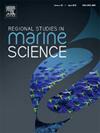Ecotoxicological assessment of polycyclic aromatic hydrocarbons and fish biomarkers in a marine protected area
IF 2.1
4区 环境科学与生态学
Q3 ECOLOGY
引用次数: 0
Abstract
From 2019–2020, oil slicks were reported in more than a thousand coastal locations along the Brazilian Atlantic coast. The Marine Protected Area Costa dos Corais (MPACC), located in the states of Pernambuco and Alagoas, Brazil, was among the most affected regions. This study investigates the feeding behavior of fish species, the presence of polycyclic aromatic hydrocarbons (PAHs) in sediments and white muscle, PAHs-like metabolites in bile, and oxidative damage to DNA (deoxyribonucleic Acid), proteins, and lipids in the liver, gills, and muscle of three fish species collected from the MPACC. The results indicate low to moderate levels of PAHs in sediments, originating from both pyrolytic and petrogenic sources. Mugil curema primarily ingested sand, followed by algae; Eugerres brasilianus consumed animal-derived items and algae, while Odontoscion dentex fed on fish fragments (such as scales), detritus, and crustaceans. The sum of four PAHs (benzo[a]pyrene, chrysene, benzo[b]fluoranthene, and benzo[a]anthracene) in white muscle exceeded the European Union’s recommended threshold for safe human consumption (30 ng g⁻¹; EU Regulation No. 835/2011). Eugerres brasilianus and Mugil curema exhibited significant positive correlations between lipid damage in liver and naphthalene-type metabolites in bile and PAHs concentrations in white muscle, respectively. Additionally, the set of biomarkers (PAH-type metabolites in bile, DNA damage, TBARs, and carbonyl proteins) collectively demonstrates their potential for assessing fish species inhabiting contaminated tropical aquatic environments, as they were found to be inter-correlated. The findings of this study provide valuable insights into the ecological impacts of tropical environments contamination and can support the development of management and recovery strategies for Brazilian marine protected areas affected by oil spills.
求助全文
约1分钟内获得全文
求助全文
来源期刊

Regional Studies in Marine Science
Agricultural and Biological Sciences-Ecology, Evolution, Behavior and Systematics
CiteScore
3.90
自引率
4.80%
发文量
336
审稿时长
69 days
期刊介绍:
REGIONAL STUDIES IN MARINE SCIENCE will publish scientifically sound papers on regional aspects of maritime and marine resources in estuaries, coastal zones, continental shelf, the seas and oceans.
 求助内容:
求助内容: 应助结果提醒方式:
应助结果提醒方式:


